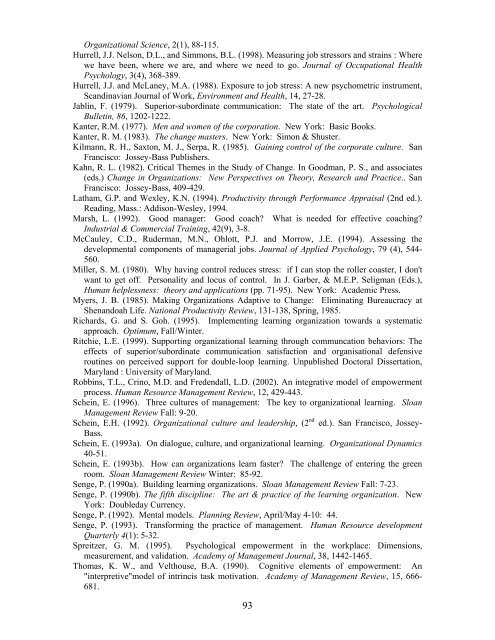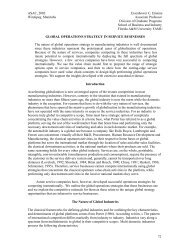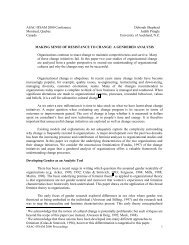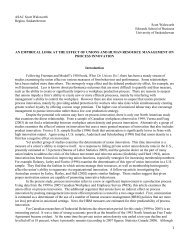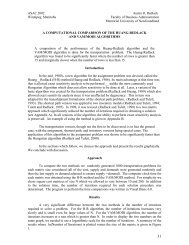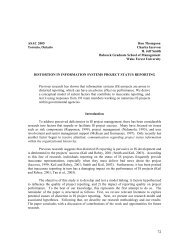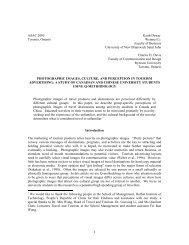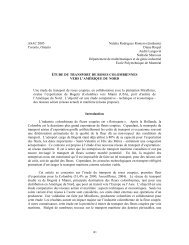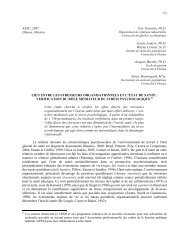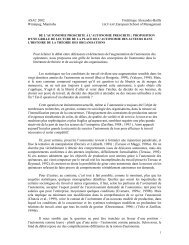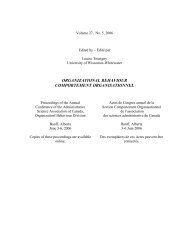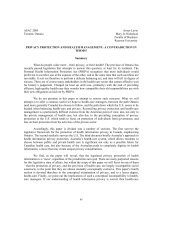complètement ce construit. Ces changements devraient améliorer la mesure de ce construit etaugmenter la variance afin d’améliorer le pouvoir de prédiction. Malgré ces limites, cette étudefournit aux chercheurs un soutien empirique démontrant que la culture et l’habilitation sont deuxdimensions liées à l’apprentissage organisationnel. Sur le plan pratique, cette recherche permetaux gestionnaires de la fonction publique d’identifier un levier important sur lequel agir afind’accroître l’apprentissage organisationnel et influencer la culture de leur organisation dans cesens.RéférencesArgyris, C. (1993). Overcoming organizational defenses. Needham Heights, MA: A;llyn &Bacon.Argyris, C. and Schon, D. (1978). <strong>Organizational</strong> learning: A theory of action approach,Reading, MA: Addision-Wesley.Barrett, F. (1995). Creating appreciative learning cultures. <strong>Organizational</strong> Dynamics 32(5): 595-616.Barrette, J. et Durivage, A. (1997).Qualité de l’expérience et intelligence pratique: La validitécroissante des connaissances tacites à la prédiction du rendement. Applied Psychology: AnInternational Review, 46(1), 89-104.Benett, J. and O'Brien, M. (1994). The building blocks of the learning organization. TrainingJune: 41-47, 49.Block, P. (1991). The empowered manager: Positive political skills at work. San Francisco:Jossey-Bass.Burke, W. (1986). Leadership as empowering others. In S. Srivastra (Ed.), Executive power (pp.51-77). San Francisco: Jossey-Bass.Conger, J. A. and Kanungo, R. N. (1988). The empowerment process: Integrating theory andpractice. Academy of Management Review, 13 (3), 471-482.Cyert, R. M. and March, J. G. (1963). A Behavioral Theory of the Firm. Englewood Cliffs, NJ:Prentice-hall.Daft, R. (2001). Organization Theory and Design, (7 e edition). South-Western.DiBella, A., E. Nevis, E., and Gould, J. (1996). Understanding organizational learning capability.Journal of Management Studies 33(3): 361-379.Dixon, N. M. (1992). <strong>Organizational</strong> learning: A review of literature with implications for HRDprofessionnals. Human resources development quarterly, 3, 29-49.Dixon, N.M. (1993). <strong>Organizational</strong> learning. The Conference Board of Canada Report, 111-193.Dixon, N.M. (1994). The organizational learning cycle, how we can learn collectively. McGraw-Hill Book Company, London.Duxbury, L. and Higgins, C. (2001) The 2001 National Work-Life Conflict Study: Report One,Ottawa: Health Canada.Elliger, A.M. (1997). Managers as facilitators of learning in learning organizations.Unpublished Doctoral Dissertation, Athens, Georgia : University of GeorgiaEvered, R. D. and Selman, J. C. (1989). Coaching and the art of management. <strong>Organizational</strong>Dynamics, 18 (Autumn), 16-32.Ford, R.C. and Fottler, M.D. (1995). Empowerment: A matter of degree. Academy ofManagement Executive, 9, 21-28.Gephart, M., V. Marsick, V. Van Buren, M., and Spiro, M. (1966). The learning organization.Training and Development, December: 35:45.Hardy, C., and Leiba-O'Sullivan, S. (1998). The power behind empowerment: implications forresearch and practice. Human Relations, 51(4), 451-483.Hedberg, B. (1981). How organizations learn and unlearn. In Handbook of <strong>Organizational</strong>Design, ed. P. Nystrom and W. Starbuck, 3-27. New York: Oxford university Press.Huber, G. (1991) <strong>Organizational</strong> learning: The contributing processes and the literatures.92
<strong>Organizational</strong> Science, 2(1), 88-115.Hurrell, J.J. Nelson, D.L., and Simmons, B.L. (1998). Measuring job stressors and strains : Wherewe have been, where we are, and where we need to go. Journal of Occupational HealthPsychology, 3(4), 368-389.Hurrell, J.J. and McLaney, M.A. (1988). Exposure to job stress: A new psychometric instrument,Scandinavian Journal of Work, Environment and Health, 14, 27-28.Jablin, F. (1979). Superior-subordinate communication: The state of the art. PsychologicalBulletin, 86, 1202-1222.Kanter, R.M. (1977). Men and women of the corporation. New York: Basic Books.Kanter, R. M. (1983). The change masters. New York: Simon & Shuster.Kilmann, R. H., Saxton, M. J., Serpa, R. (1985). Gaining control of the corporate culture. SanFrancisco: Jossey-Bass Publishers.Kahn, R. L. (1982). Critical Themes in the Study of Change. In Goodman, P. S., and associates(eds.) Change in Organizations: New Perspectives on Theory, Research and Practice.. SanFrancisco: Jossey-Bass, 409-429.Latham, G.P. and Wexley, K.N. (1994). Productivity through Performance Appraisal (2nd ed.).Reading, Mass.: Addison-Wesley, 1994.Marsh, L. (1992). Good manager: Good coach? What is needed for effective coaching?Industrial & Commercial Training, 42(9), 3-8.McCauley, C.D., Ruderman, M.N., Ohlott, P.J. and Morrow, J.E. (1994). Assessing thedevelopmental components of managerial jobs. Journal of Applied Psychology, 79 (4), 544-560.Miller, S. M. (1980). Why having control reduces stress: if I can stop the roller coaster, I don'twant to get off. Personality and locus of control. In J. Garber, & M.E.P. Seligman (Eds.),Human helplessness: theory and applications (pp. 71-95). New York: Academic Press.Myers, J. B. (1985). Making Organizations Adaptive to Change: Eliminating Bureaucracy atShenandoah Life. National Productivity Review, 131-138, Spring, 1985.Richards, G. and S. Goh. (1995). Implementing learning organization towards a systematicapproach. Optimum, Fall/Winter.Ritchie, L.E. (1999). Supporting organizational learning through communcation behaviors: Theeffects of superior/subordinate communication satisfaction and organisational defensiveroutines on perceived support for double-loop learning. Unpublished Doctoral Dissertation,Maryland : University of Maryland.Robbins, T.L., Crino, M.D. and Fredendall, L.D. (2002). An integrative model of empowermentprocess. Human Resource Management Review, 12, 429-443.Schein, E. (1996). Three cultures of management: The key to organizational learning. SloanManagement Review Fall: 9-20.Schein, E.H. (1992). <strong>Organizational</strong> culture and leadership, (2 nd ed.). San Francisco, Jossey-Bass.Schein, E. (1993a). On dialogue, culture, and organizational learning. <strong>Organizational</strong> Dynamics40-51.Schein, E. (1993b). How can organizations learn faster? The challenge of entering the greenroom. Sloan Management Review Winter: 85-92.Senge, P. (1990a). Building learning organizations. Sloan Management Review Fall: 7-23.Senge, P. (1990b). The fifth discipline: The art & practice of the learning organization. NewYork: Doubleday Currency.Senge, P. (1992). Mental models. Planning Review, April/May 4-10: 44.Senge, P. (1993). Transforming the practice of management. Human Resource developmentQuarterly 4(1): 5-32.Spreitzer, G. M. (1995). Psychological empowerment in the workplace: Dimensions,measurement, and validation. Academy of Management Journal, 38, 1442-1465.Thomas, K. W., and Velthouse, B.A. (1990). Cognitive elements of empowerment: An"interpretive"model of intrincis task motivation. Academy of Management Review, 15, 666-681.93
- Page 1 and 2:
Volume 24, No. 5, 2003Edited by/Éd
- Page 4 and 5:
Pursey HeugensGreg IrvingRoderick I
- Page 6 and 7:
TABLE OF CONTENTS - TABLE DES MATI
- Page 8 and 9:
study of power displays in mixed-ge
- Page 10 and 11:
on expectations and behaviour (Berg
- Page 12 and 13:
TaskThis study required the use of
- Page 14 and 15:
Task-Gender (male-stereotyped or fe
- Page 16 and 17:
It is important to understand the s
- Page 18 and 19:
Crown, C.L. & Cummins, D.A. (1998).
- Page 20 and 21:
Smith-Lovin, L., & Brody, C. (1989)
- Page 22 and 23:
Table 2Summary of Descriptive Stati
- Page 24 and 25:
Table 4Summary of Interaction of Ge
- Page 26 and 27:
ASAC 2003Halifax, Nova ScotiaIain L
- Page 28 and 29:
the interrelationships among the MB
- Page 30 and 31:
studies (Friedman and Sarros, 1989;
- Page 32 and 33:
This study demonstrated that emotio
- Page 34 and 35:
Anxiety, Stress and Coping, in pres
- Page 36 and 37:
Washington, DC: Taylor and Francis,
- Page 38 and 39:
Table 2Overall Goodness-of-Fit Indi
- Page 40 and 41:
ζ 3Depersonalizationη 3β 3,1 (+)
- Page 42 and 43:
ASAC 2003Halifax, Nova ScotiaWendy
- Page 44 and 45:
views independently, gave rise to S
- Page 46 and 47:
track assistant, associate, and ful
- Page 48 and 49: ole conflict are positively related
- Page 50 and 51: Table 3. Regression of climate and
- Page 52 and 53: interests.We speculate the null eff
- Page 54 and 55: DOOP and short for DOOP scales,”
- Page 56 and 57: Pelled, L. H., “Demographic diver
- Page 58 and 59: esulting increase in discretion ove
- Page 60 and 61: al., 1995). However, the distinctio
- Page 62 and 63: ise to strong pressures for conform
- Page 64 and 65: presented with a complete list of a
- Page 66 and 67: Table 3QAP Regression Coefficients
- Page 68 and 69: ConclusionResearchers of social inf
- Page 70 and 71: suggestions for further research.
- Page 72 and 73: performing on the job.” Presumabl
- Page 74 and 75: positively related to performance i
- Page 76 and 77: proposed hypotheses were supported.
- Page 78 and 79: ConclusionThis research has made se
- Page 80 and 81: Be more enthusiastic and exert extr
- Page 82 and 83: Table 2Correlations Among the Laten
- Page 84 and 85: performance expectations on feedbac
- Page 86 and 87: changements qui s’opèrent dans l
- Page 88 and 89: structures, politiques, systèmes,
- Page 90 and 91: comportements liés à la communica
- Page 92 and 93: Tableau 2Échelles de mesure de la
- Page 94 and 95: prédiction des compétences clés
- Page 96 and 97: organisation n’est pas uniforme e
- Page 100 and 101: Wagner, R.K. and Sternberg, R.J. (1
- Page 102 and 103: What is a toxin handler?In two arti
- Page 104 and 105: potentially limited scope and conte
- Page 106 and 107: work role demands. In this survey,
- Page 108 and 109: The three factors in this rotated f
- Page 110 and 111: and service orientation, the abilit
- Page 112 and 113: ASAC 2003Halifax, Nova ScotiaLisa M
- Page 114 and 115: self-appraisal group reacted more n
- Page 116 and 117: effect of voice are the value-expre
- Page 118 and 119: “Strongly Disagree” to “Stron
- Page 120 and 121: esults suggest that incorporating s
- Page 122 and 123: Personality and Social Psychology,
- Page 124 and 125: Table 1Means, Standard Deviations,
- Page 126 and 127: Table 3Test of the Mediating Role o
- Page 128 and 129: ASAC 2003Halifax, Nova ScotiaAnn Fr
- Page 130 and 131: individual level, polychronicity is
- Page 132 and 133: construct.Drawing on computer-media
- Page 134 and 135: Consequence: Impact on Work Overloa
- Page 136 and 137: Conversation complexity may also mo
- Page 138: Implications for practiceFuture res
- Page 141 and 142: ReferencesAncona, D.G., Goodman, P.
- Page 143 and 144: no. 3 (1994): 381-391.Macan, T.H.,
- Page 145 and 146: ASAC 2003Halifax, Nova ScotiaIan R.
- Page 147 and 148: Assessing Measures: Affective Commi
- Page 149 and 150:
implications of psychological contr
- Page 151 and 152:
commitment, affective commitment, c
- Page 153 and 154:
Motivational Process Variables. Amo
- Page 155 and 156:
DiscussionThe main purpose of this
- Page 157 and 158:
approaches zero. In the present stu
- Page 159 and 160:
Extension and test of a three-compo
- Page 162 and 163:
Table 1Descriptive Statistics and Z
- Page 164 and 165:
Table 3Standardized Factor Loadings
- Page 166 and 167:
Table 5Hierarchical Regression Anal
- Page 168 and 169:
ASAC 2003Halifax, Nova ScotiaJoan F
- Page 170 and 171:
ASAC 2003Halifax, Nova ScotiaArla D
- Page 172 and 173:
ASAC 2003Halifax, Nova ScotiaIvy Ky
- Page 174:
ASAC 2003Halifax, Nova ScotiaNina D


